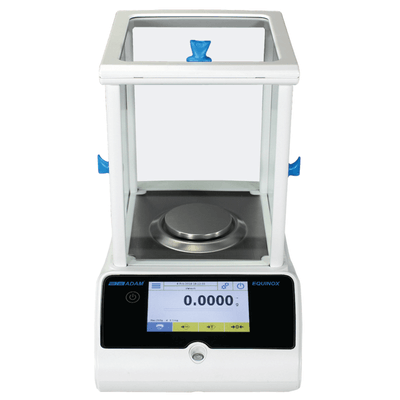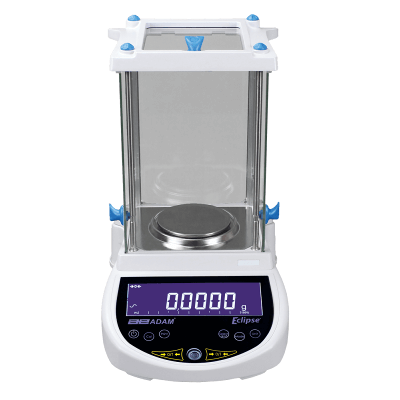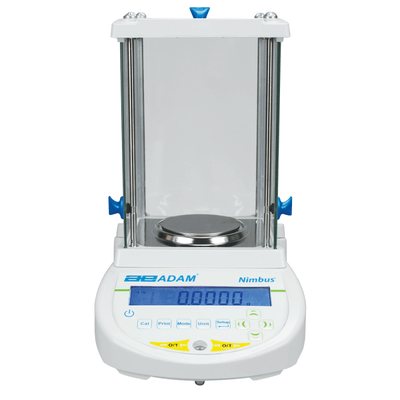Analytical Balances:
An analytical balance (or lab balance) is a class of balance designed to measure small mass in the sub-milligram range. Analytical balances are highly sensitive and accurately measure mass with readability ranging between 0.1 mg - 0.01 mg (0.0001 g – 0.00001 g). These balances usually have a transparent draft shield or weighing chamber to prevent air currents and dust from affecting the weighments.
Components of an analytical balance include:
- balance main body
- draft shield
- weighing pans
- level indicator
- adjustable feet
- communications interface
- calibration weight
- power cord and other accessories
- software
Analytical balances detect very fine increments, so the slightest vibration or breeze can impact the results. As such, analytical balances should be used in a dedicated room with as few disturbances as possible. In certain environments, these balances are installed on anti-vibration tables to increase accuracy. Analytical balances need to be monitored carefully and calibrated frequently. Most analytical balances have both automatic internal motorized calibration and calibration with external weights.
What makes analytical balances different from other balances?
Analytical balances are designed to handle very precise measurements samples. Precision balances usually have a higher capacity and readability than analytical balances with readability ranging between 0.1 g - 1 mg. Analytical balances can take longer than precision balances to stabilize and the balance must be stable in order to produce reliable results. Analytical balances are much more sensitive to changes, and can detect smaller variations in mass. For acute measurements in labs, analytical balances are the right choice.
Unlike top-loading balances, analytical balances usually have a weighing chamber that encloses the weighing pan with glass doors to prevent interference from vibration or air currents. The weighing pan is usually smaller than in precision balances, and can only accommodate small samples. Higher tolerance calibration weights are used in calibration procedures to ensure precision results.
Common features found on an analytical balance
Analytical balances usually come with many features and functions. Most of them have counting and check counting applications, for example. These can be useful when counting pills, ingredients or very small pieces. Dynamic weighing is also very useful, as it allows lab professionals to weigh unstable samples such as liquids, small animals, or insects. Percentage weighing allows for quicker, more efficient formulation, and is quite handy for chemistry and pharmaceutical applications. Accumulation ensures you can have large results despite the balance's small capacity; instead of having all the material on the balance at one time, you can accumulate the results of doses or packaging to receive a total without putting all the product on the balance at the same time.
ISO and Good Laboratory Practice (GLP) compliant reports are essential for laboratory work. Having the balance automatically fill relevant fields can save time and allow researchers to spend more time on their work and less time formatting. This is a feature that's especially important for use in quality control.
A bright, well-lit display with multilingual software allows the balance to be used in a variety of countries, or by multilingual staff and students.
Useful accessories to use with your analytical balance
Reliable and robust analytical balances provide precise results and easy data transfer with connection to peripheral devices via USB, RS232 and optional Bluetooth.
USB and RS-232 interfaces are very useful for sending data to computers and printers, which can save time and help with later in-depth analysis. Couple that with GLP/ISO compliant printouts to save even more time and efforts. You can pair analytical balances with software for further data analysis of your results. A security lock can prevent theft and make sure the balance isn't moved from the room. Quality assurance features help you comply with regulations and industry standards.
Density kits are popular accessories in labs and in classrooms, as they allow the balance to make density and specific gravity measurements.
It's a good idea to keep calibration weight sets on hand to ensure you can calibrate your balance frequently. An anti-vibration table can create a dedicated workstation and calibration station, and ensure the balance is stable and has less interference to contend with during measurements for reliable results.
For easy cleaning, you can remove the draft shield glass panels from your balance without any tools and wipe down the interior.
Closing Words
At American Scale we strive to bring you informed and useful content on all things scale related. Be sure to check out our legal for trade truck scale system articles about truck scale foundation or how much do truck scales cost. We even have a guide to warranties. We also have articles on scale accessories, common problems to prolong your scales lifespan, weighing applications as well as what scale indicator works best with your junction box. To learn more about bench scales, it would be good to check out our other articles such as “Bench Scale Basics'' and “How Much Does A Bench Scale Cost?”. These articles will help with the basics of bench scale ownership.



